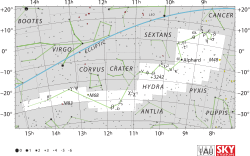Epsilon Hydrae

| |
| Observation data Epoch J2000.0 Equinox J2000.0 | |
|---|---|
| Constellation | Hydra |
| Right ascension | 8h 46m 46.51223s[1] |
| Declination | +06° 25′ 07.6855″[1] |
| Apparent magnitude (V) | AB: 3.38[2] C: 7.5[3] |
| Characteristics | |
| Spectral type | AB: G5 III + F0 V[4] C: F5[3] |
| U−B color index | +0.37[5] |
| B−V color index | +0.68[5] |
| Astrometry | |
| Radial velocity (Rv) | +36.4[6] km/s |
| Proper motion (μ) | RA: −228.11[1] mas/yr Dec.: −43.82[1] mas/yr |
| Parallax (π) | 25.23 ± 0.98[1] mas |
| Distance | 129 ± 5 ly (40 ± 2 pc) |
| Orbit[7] | |
| Primary | ε Hya A |
| Companion | ε Hya B |
| Period (P) | 5,478.98 ± 93.19 days |
| Semi-major axis (a) | 0.226[8]" |
| Eccentricity (e) | 0.652 ± 0.020 |
| Inclination (i) | 49.3° |
| Periastron epoch (T) | 2437060.85 ± 63.86 |
| Argument of periastron (ω) (secondary) | 74.66 ± 0.21° |
| Semi-amplitude (K1) (primary) | 8.05 ± 0.14 km/s |
| Details | |
| ε Hya A | |
| Luminosity | 67[2] L☉ |
| Temperature | 5,620[2] K |
| Rotational velocity (v sin i) | 19[8] km/s |
| Other designations | |
Epsilon Hydrae (ε Hya, ε Hydrae) is a Class G5, third-magnitude star system in the constellation Hydra. This stellar system is located about 129 light-years (40 parsecs) from Earth.[1]
It is a multiple star system having at least four stellar components. The pair ε Hya AB form a binary star with an orbital period of 15 years and an angular separation of 0.2 arcseconds. Component ε Hya C is separated from the AB pair by 3 arcseconds. It is a spectroscopic binary system with a period of 9.9047 days[7] and an orbital eccentricity of 0.62,[8] while simultaneously orbiting ε Hya AB with a period of 870 years. The fourth component, ε Hya D, shares a common proper motion with the other components and thus is most likely a gravitationally-bound member of the system. It is separated from the AB pair by 19 arcseconds and has an estimated orbital period of around 10,000 years.[7]
The primary, ε Hya A, is a giant star that is shining with 67 times the luminosity of the Sun. This energy is being radiated from the star's outer atmosphere at an effective temperature of 5,620 K,[2] giving it the yellow hue of a G-type star. It is rotating rapidly with a projected rotational velocity of 19 km s−1.[8] It has an X-ray luminosity of 2.8 × 1029 erg s−1.[4]
Name and etymology
This star, along with δ Hya (Lisan al Sudja), ζ Hya, η Hya, ρ Hya and σ Hya (Minhar al Shija), were Ulug Beg's Min al Azʽal, "Belonging to the Uninhabited Spot".[9]
According to the catalogue of stars in the Technical Memorandum 33-507 - A Reduced Star Catalog Containing 537 Named Stars, Min al Azʽal or Minazal were the title for five stars:δ Hya as Minazal I, η Hya as Minazal II, ε Hya as Minazal III, ρ Hya as Minazal IV and ζ Hya as Minazal V (exclude σ Hya)[10]
In Chinese, 柳宿 (Liǔ Sù), meaning Willow (asterism), refers to an asterism consisting of ε Hydrae, δ Hydra, σ Hydrae, η Hydrae, ρ Hydrae, ζ Hydrae, ω Hydrae and θ Hydrae[11] Consequently, ε Hydrae itself is known as 柳宿五 (Liǔ Sù wǔ, English: the Fifth Star of Willow.)[12]
In ancient Indian astronomy, the five-star cluster of Hydrae is collectively called Ashlesha (Ayilyam in southern India) Nakshatras
The people of Groote Eylandt called Unwala, "The Crab", for the star cluster including this star, δ Hya (Lisan al Sudja), ζ Hya, η Hya, ρ Hya and σ Hya (Minhar al Shija).[13]
References
- 1 2 3 4 5 6 van Leeuwen, F. (November 2007), "Validation of the new Hipparcos reduction", Astronomy and Astrophysics, 474 (2): 653–664, arXiv:0708.1752
 , Bibcode:2007A&A...474..653V, doi:10.1051/0004-6361:20078357
, Bibcode:2007A&A...474..653V, doi:10.1051/0004-6361:20078357 - 1 2 3 4 Mallik, Sushma V. (December 1999), "Lithium abundance and mass", Astronomy and Astrophysics, 352: 495–507, Bibcode:1999A&A...352..495M
- 1 2 Pourbaix, D.; et al. (September 2004), "SB9: The ninth catalogue of spectroscopic binary orbits", Astronomy and Astrophysics, 424: 727–732, arXiv:astro-ph/0406573
 , Bibcode:2004A&A...424..727P, doi:10.1051/0004-6361:20041213
, Bibcode:2004A&A...424..727P, doi:10.1051/0004-6361:20041213 - 1 2 Makarov, Valeri V. (October 2003), "The 100 Brightest X-Ray Stars within 50 Parsecs of the Sun", The Astronomical Journal, 126 (4): 1996–2008, Bibcode:2003AJ....126.1996M, doi:10.1086/378164
- 1 2 Johnson, H. L.; et al. (1966), "UBVRIJKL photometry of the bright stars", Communications of the Lunar and Planetary Laboratory, 4 (99), Bibcode:1966CoLPL...4...99J
- ↑ Wilson, R. E. (1953). General Catalogue of Stellar Radial Velocities. Carnegie Institute of Washington D.C. Bibcode:1953GCRV..C......0W.
- 1 2 3 Bakos, G. A.; Tremko, J. (1987), "Spectroscopic orbital elements and photometry of the multiple system epsilon Hydrae", Contributions of the Astronomical Observatory Skalnaté Pleso, 16: 17–26, Bibcode:1987CoSka..16...17B
- 1 2 3 4 Strassmeier, Klaus G.; Hall, Douglas S. (August 1988), "Photometric variability in chromospherically active stars. I - The constant stars", Astrophysical Journal Supplement Series, 67: 439–451, Bibcode:1988ApJS...67..439S, doi:10.1086/191278
- ↑ Allen, R. H. (1963). Star Names: Their Lore and Meaning (Reprint ed.). New York, NY: Dover Publications Inc. p. 249. ISBN 0-486-21079-0. Retrieved 2010-12-12.
- ↑ Rhoads, Jack W. (November 15, 1971), Technical Memorandum 33-507-A Reduced Star Catalog Containing 537 Named Stars (PDF), Jet Propulsion Laboratory, California Institute of Technology
- ↑ (Chinese) 中國星座神話, written by 陳久金. Published by 台灣書房出版有限公司, 2005, ISBN 978-986-7332-25-7.
- ↑ (Chinese) AEEA (Activities of Exhibition and Education in Astronomy) 天文教育資訊網 2006 年 5 月 28 日
- ↑ Encyclopaedia of the history of science, technology, and medicine in non-western cultures, ed. Helaine Selin, Dordrecht, Kluwer Academic Publishers, 1997, p.105.
External links
- "HD 74874 -- Variable Star". SIMBAD Astronomical Database. Retrieved 2006-11-05.